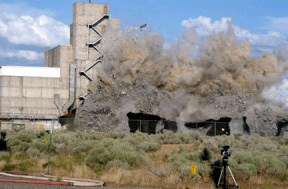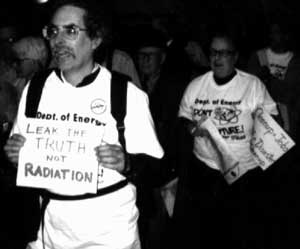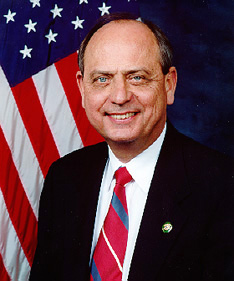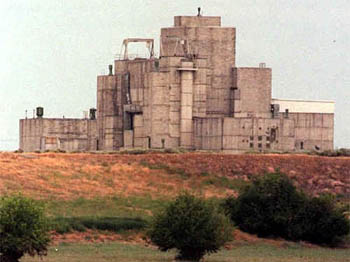|
Week of September 20, 2004 Snapshot from the Field |
|
LOOKING FOR A PREVIOUS STORY? CHECK THE
ARCHIVE.
Problems Aplenty Hitting Washington's
$6-Billion Nuke-Cleanup Plant by JACK LYNE,Site Selection Executive Editor of Interactive Publishing
HANFORD, Wash. - And you
thought your project had tons of problems?
weapon plant site. The project is getting pounded by a legion of large-size woes. The Hanford site's troubles include major cost overruns expected to total billions of dollars, leaking radioactivity from 177 aging underground tanks, charges of unsafe practices, and widespread public opposition. In short, the cleanup is looking a lot like Joe Btfsplk, the perennially jinxed "Li'l Abner" character with a dark storm cloud forever perched a foot above his head. Joe, though, was a haplessly humorous figure. In contrast, the 375,000-acre (150,000-hectare) Hanford site near the Columbia River comprises the largest U.S. concentration of radioactive waste. Some of that deadly load has a lethal lifespan of millions of years; and all of it must somehow be made safe - or at least safer. Overseen by the DOE, construction of the Hanford plant began in the summer of 2002 (see accompanying time line). The finished treatment facility will vitrify the waste, a byproduct of producing plutonium for nuclear bombs. Waste will be dissolved into a glasslike substance and emptied into thick steel canisters. The canisters will then be welded shut and shipped to a permanent underground storage facility - probably in Yucca Mountain, Nev. Vitrification has been used similarly before. But never before on so vast a scale. At full bore, the Hanford cleanup will employ some 10,000 workers.
GAO Criticizes 'High-Risk Strategy'
One of the Hanford plant's most critical
broadsides came in a July report from the Government Accountability
Office (GAO at www.gao.gov), the Congressional agency that oversees
federal programs. (Formerly known as the General Accounting Office,
the organization officially changed its name on July 8th as part of
the GAO Human Capital Reform Act.) The DOE, the GAO's report charged, "has adopted a high-risk strategy" for the Hanford cleanup. The energy agency's current strategy at the desert site revolves around fast-track construction. With that sped-up style, the Hanford plant's construction, design and technology development are all carried out concurrently. The DOE went to the fast-track system in 2002, trying to meet a legally binding 2028 deadline. That deadline was established in a 1989 agreement between the federal government, the U.S. Environmental Protection Agency and Washington state's Department of Ecology. Without fast-tracking, the DOE explained, the project wouldn't be finished until 2046. But with fast-tracking, it said, cleanup would be completed almost 20 years faster, with its estimated $56-billion cost dropping to $36 billion. But the GAO gave the all-at-once system very poor marks. The Hanford plant's construction "departs from conditions appropriate for fast-track management," the agency said in its report. "For projects of Hanford's complexity, this approach is not compatible with controlling costs and schedules."
"By speeding up the project, the Energy Department hasn't fully investigated alternative approaches to separating the tank waste, a key step to the treatment process that precedes . . . vitrifying it," the GAO's report noted. "That omission could cost the project about $50 million annually and locks it into a sole provider of a product key to the process." And $50 million a year times 20 to 40 years could make for a whopper of an added cost. Sticker shock, though, is nothing new for the project. The estimated cost of building the Hanford plant has dramatically escalated several times. The first of those increases came after DOE signed the U.S. subsidiary of BNFL (formerly known as British Nuclear Fuels Limited) in 1998 to design the Hanford facility. That contract had earlier been put out for bid as part of the DOE's privatization program, initiated in 1995 for cleaning up the agency's own contaminated sites. The British firm at the time also said that it also hoped to land the contract to build and operate the Hanford treatment plant. Initially, BNFL estimated that building the vitrification plant would cost $3.2 billion. After two years of design work, though, BNFL's cost estimate had skyrocketed to $15.2 billion. That escalation, plus concerns over
In remarks that some observers feel may prove prophetic, Collum said, "We were obviously sorry to lose the Hanford contract, but in fact it was an inappropriate contract for BNFL. It was inappropriate because the contract promised too little reward and left us with a high level of financial risk." The DOE then bid out the contract to build and operate the Hanford plant. In late 2000, the agency signed the team of Bechtel National, the government services arm of engineering giant Bechtel Group (www.bechtel.com), and Washington Group International (www.wgint.com). The two firms formed Bechtel-led Bechtel Washington to manage the project. Bechtel Washington originally estimated that plant construction would cost about $4.3 billion. But that figure, too, has since inflated to some $6 billion - in part because the DOE decided it needed a bigger plant for faster cleanup.
'Tens of Billions' More?
In addition, the GAO report suggests that
even more severe cost shocks could be looming. "DOE has not adequately defined or communicated the potential effects of a legal challenge to its overall plan for minimizing how much high-level waste is disposed of in an underground repository," the federal accountability agency charged. And what could be the upshot if that problem isn't effectively managed? "An adverse legal outcome could increase project costs by tens of billions of dollars," said the GAO. Like money, time is slip-sliding away on the Hanford project. Initially, the vitrification plant was scheduled to begin treatment in December 2002, completing processing of about 6 percent of the site's total waste by 2007. By 1998, though, the DOE moved the facility's estimated startup back to February 2007, with some 10 percent of total processing completed by 2018. Today, with some 30 percent of the plant completed, the DOE says the facility won't start treating waste until 2011. The fast-track method has been one major time-eater, says the GAO. Parts of the project team (e.g., construction) have been ready to go when other parts (e.g., design) haven't.
'DOE Wants to Reclassify
That ever-receding timeline imperils meeting
the 2028 deadline. The DOE now seems to be pinning its hopes of hitting
that target on reclassifying some of the Hanford waste as "incidental."
The DOE wants that categorization to apply to tank residue left behind
after liquid and sludge waste has been pumped out. Some Hanford Waste as 'Incidental' Incidental nuclear waste doesn't require vitrification, the most expensive cleanup technology. Instead, the DOE could encase the residue in thick grout, fill the waste storage tanks with concrete and leave it there. That, the DOE claims, would save $350 million. But without the reclassification, it adds, the cleanup
The DOE failed earlier this year to get Congress to reclassify the Hanford residue. Now, it's working through the federal courts to get the re-categorization. Unsurprisingly, the DOE's reclassification effort isn't playing well in much of southeast Washington. "Leaving waste in tanks that have already leaked contamination that threatens to poison our Columbia River . . . is not cleanup, no matter what name the administration gives its scheme," said Gerald Pollet, executive director of Heart of America Northwest (www.heartofamericanorthwest.org), a Hanford-based public interest group. "Washington's voters have proven in the past that we won't let DOE make us into a national radioactive waste dump. Any child can tell you that we can't clean up this dangerous mess by . . . trying to hide the wastes by pouring concrete on top of them."
'Washington's Initiative 297 Would
Washington's Initiative 297 also reflects
the Hanford plant's persona-non-grata status. Block Incoming Waste Shipments I-297, which goes before state voters in November's elections, would stop the DOE from bringing additional nuclear waste to Hanford until the site's existing waste is cleaned up. The initiative made the ballot early this year, when supporters turned in a petition signed by 280,000 Washington voters - the highest total in state history. "Initiative 297 will change state law to reflect the principle we all learned in kindergarten: You have to clean up your mess before adding to it," said Pollet. Currently, the Hanford site annually accepts some 21,000 gallons (79,800 liters) of low-level nuclear waste from other former U.S. nuclear weapon plants and labs. Trucking that volume in would require filling about 55 trucks with 70 barrels, each containing 55 gallons (209 liters) of waste. Incoming volume could increase dramatically, though, with the Bush administration's plan for nuclear waste consolidation. Hanford is scheduled to be one of several key DOE consolidation centers until underground storage facilities are completed in Carlsbad, N.M. and Yucca. Some industry analysts anticipate that consolidation will produce a tenfold increase in Hanford's incoming waste every year through 2046. Most of the new shipments will be low-level waste, the DOE maintains. But the federal agency also concedes that hundreds of trucks rolling into Hanford will contain transuranic waste that is highly radioactive. In the past, the Washington plant received intermittent transuranic shipments. That ended last year, though, when state officials and
I-297 supporters are particularly concerned over transuranic shipments over secondary roads in an area where winters hit hard. Initiative backers are also worried about adding more dangerous pollution. Radioactive and toxic-chemical contamination has already been found in more than 128,000 acres (57,200 hectares) of groundwater. "The health risks along the Columbia River are unacceptable if we allow the [DOE] to double the amount of waste buried in Hanford's soil, allow leaks of high-level nuclear waste to spread, and keep dumping radioactive waste in unlined soil trenches," charged Jim Trombold, a member of Washington Physicians for Social Responsibility (www.wpsr.org), a group backing I-297.
'Congressman: I-297
At this point, I-297 seems headed toward passage.
Some 70 percent of Washington voters surveyed in June said they support
the initiative, according to results released by Seattle-based pollster
Don McDonough. Could Backfire Badly But that remedy may not be as simple as it seems, says U.S. Rep. Doc Hastings (R), whose district includes Hanford. "[I-297] is deeply flawed and should be defeated," Hastings said in an Aug. 25th meeting of the Tri-City Area Chamber of Commerce in Kennewick, Wash. "The fundamental failure of I-297 is that while it tries to keep waste from coming into Washington state, it gambles all of Hanford's massive volumes of nuclear waste that other states won't do the same thing." Legal experts don't know whether such an initiative would withstand a legal challenge. But if every state passes a similar restriction and all hold up in court, making high-level nuclear waste less lethal would seem virtually impossible. As Hastings said in Kennewick, "If Washington loses the I-297 gamble, then we may get to forever keep the 90 percent of Hanford waste currently headed out of our state." At this point, lawyers look like nuclear cleanup's only clear winners. Numerous lawsuits are sure to be a courtroom fixture for many years. Meanwhile, nuclear waste like that sitting in Hanford still requires treatment. And that's going to be expensive. Recent cost estimates for cleaning up all U.S. nuclear waste are around $230 billion. And, as the Hanford project demonstrates, the final figure could be much more than that. Then again, $230 billion is only 4 percent of the estimated $5.8 trillion spent in the U.S. since 1940 on developing nuclear arms. 
|
||||||||||||||||||||||||||||||||
PLEASE VISIT OUR SPONSOR • CLICK ABOVE 
|
||||||||||||||||||||||||||||||||






